![]()
![]()
![]()
Use LEFT and RIGHT arrow keys to navigate between flashcards;
Use UP and DOWN arrow keys to flip the card;
H to show hint;
A reads text to speech;
78 Cards in this Set
- Front
- Back
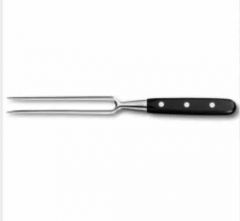
A carving_________ is a long, two-pronged________ used to hold meat steady while it is being cut. |
Chef's Fork |
|
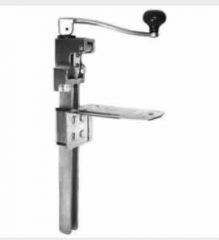
|
Table-Mounted Can Opener |
|
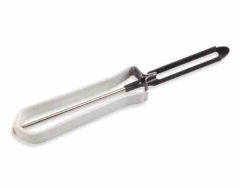
A __________ is a kitchen tool consisting of a slotted metal blade attached to a handle that is used to remove the outer skin or peel of certain vegetables, often potatoes and carrots, and fruits such as apples, pears, etc. |
Vegetable Peeler |
|
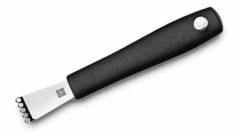
Used for citrus rinds, oranges, limes and lemons for garnish or as ingredients in food |
Zester |
|
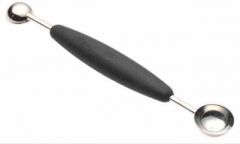
Used for making Parisienne cuts that end up spherical. |
Melon-Ball Cutter |
|
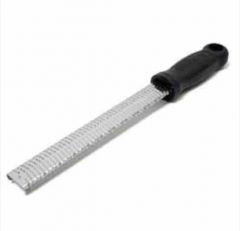
Used for zesting and grating |
Rasp-Style Grater |
|
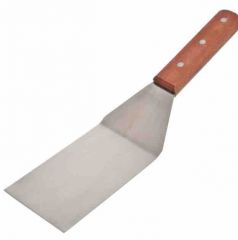
Used for flat top griddles or grills. |
Grill Spatulas |
|
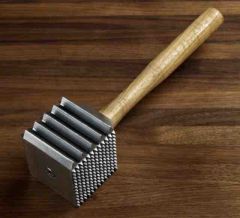
Used for tenderizing meat |
Meat Mallet |
|
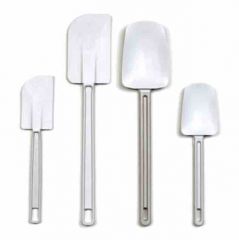
Used for scraping the insides of bowls and getting remaining liquids, batters or sauces. A mixing tool. |
Rubber Spatulas |
|
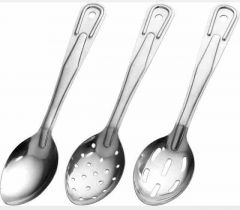
Used for staining, stirring and serving |
Perforated, Plain and Slotted Spoons |
|
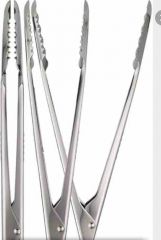
Used for grabbing hot items. |
Straight Tongs |
|
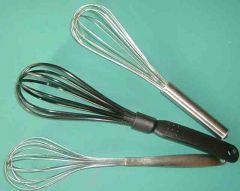
|
Balloon & Rigid Whisks |
|

Used for spreading frosting |
Straight Spatula (cake spatula) |
|
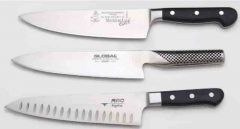
An All-purpose knife used for chopping, slicing and mincing it's rigid 8 to 14 inch long blade is wide at the heel and tapers to a point at the tip. |
French or Chef's Knife |
|
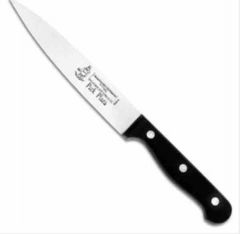
An all purpose knife used for cutting fruits and vegetables and carving poultry. It's rigid 6 to 8 inch long blade is shaped like a chefs knife but narrower |
Utility Knife |
|

A smaller knife with a thin blade used to separate meat from bone. The blade is usually 5 to 7 inches long and maybe flexible or rigid. |
Rigid Boning Knife |
|
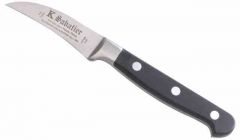
A short knife used for detail work or cutting fruits and vegetables. The rigid blade is from 2 to 4 inches long. A tournée or birds beak knife is smaller to a paring knife but with a curved blade; it is used to cut curved surfaces or tournèe vegetables. |
Paring Knife |
|
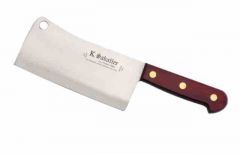
A knife with a large, heavy rectangular blade used for chopping or cutting through bones. |
Cleaver |
|
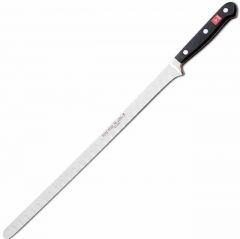
A knife with a long, thin blade used primarily for slicing cooked meat. The tip maybe round or pointed, and the blade maybe flexible or rigid. A small similar knife with a serrated edge is used for slicing bread or pastry items. |
Flexible slicer or Serrated slicer |
|

Sometimes known as scimitar because the rigid blade curves up in a 25° angle at the tip, it is used for fabricating raw meat and is available with 6 to 14 inch blades. |
Butchers knife |
|
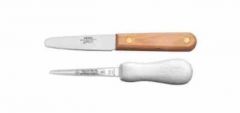
This short, rigid blades of these knives are used to open oysters and clams shells. The tips are blunt; only the clam knife has a sharp edge. |
Oyster and Clam Knives |
|

A scored, slightly abrasive steel rod used to hone or straighten a blade immediately after and between sharpenings. |
Steel |
|
|
A portion of the blade known as the _______. It fits inside the handle. The best knives are constructed with a full _______ running the length of the handle. |
Tang |
|
|
A _____ is where the blade meets the handle. The ______ is part of the blade and not a separate collar. |
Bolster |
|
|
Knife handles are often made of hardwoods infused with plastic and _______to the tang. |
Rivets |
|
|
The top of the knife running lengthwise from the tip to bolster of a knife. |
Spine |
|
|
The bottom of the knife running tip to heal that has a sharp edge. |
cutting edge |
|
|
The underneath part of the blade at the end where it meets the handle. |
Heel |
|
|
An alloy of carbon and iron, _________ is traditionally used for blades because it is soft enough to be sharpened easily. It corrodes and discolors easily, however, especially when used with acidic foods. |
Carbon steel knife |
|
|
__________ Steel, will not rust, corrode or discolor and is extremely durable. A _______ Steel blade is much more difficult to sharpen than a carbon steel one, although once and edges established, it lasts longer than the edge on a carbon steel blade. |
Stainless steel Knife |
|
|
An alloy combining the best features of Carbon steel and Stainless steel, ___________ stainless steel neither corrodes nor discolors and can be sharpened almost as easily as carbon steel. It is now the most frequently used metal for blades. |
High–Carbon Stainless Steel Knife |
|
|
A _________called zirconium oxide is now used to make knife blades that are extremely sharp, very easy to clean, rustproof and non-reactive. With proper care, ________blades will remain sharp for years, but when sharpening is needed, it must be done professionally on special diamond wheels. |
Ceramic Knife |
|
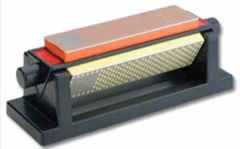
A flat brick of synthetic abrasives that is used to put an edge on a dull blade. Various grit sizes are available. The most practical set includes both course and fine grit stones. |
Three-Sided Sharpening Stone (Whetstone) |
|

________ scales use a spring mechanism, round dial in single flat tray. They're available calibrated in grams, ounces or pounds. |
Portion scale |
|
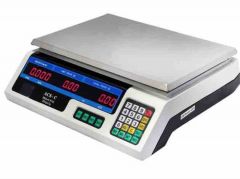
Also use a spring mechanism but provide digital readouts they are often required where foods are priced for sale by weight. An automatic tare feature alows the user to ignore the weight of the container used to hold loose ingredients on the scale, a feature that makes measuring accurately and more convenient. |
Electronic scale |
|
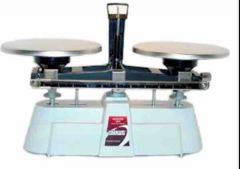
Also known as bakers scale use a two-tray, free-weight counterbalance system. A ______ scale allows more weight to be measured at one time because it is not limited by a spring capacity. |
Balance scale |
|
|
This knife has a rectangular blade and is used to cut thin vegetable garnishes. |
Usuba knife |
|
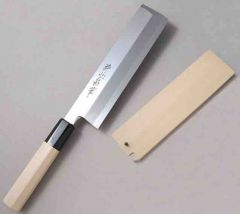
This knife has a rectangular blade and is used to cut thin vegetable garnishes. |
Usuba knife |
|

This knife has a thin 8 to 14 inch long straight blade traditionally used to cut translucent slices of raw fish fillets called sashimi and sushi rolls. |
Yanagiba knife |
|
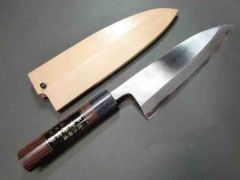
This night has a wide, sturdy 5 to 7 inch long wedge shaped blade used for butchering and boning fish. |
Deba |
|
|
You use this tool to measure by volume. When sold in set they usually include 1/4, 1/2, 1tsp, and 1 Tbl, units. |
Measuring spoons |
|
|
These are available in capacities from one cup to 1 gallon. They have a lip or pourspout above the top line of measurement to prevent spills. |
Liquid measuring cups |
|
|
These are used for dry ingredients and are usually sold in sets of 1/4, 1/3, 1/2, and 1 cup units. They do not have pour spouts, so the top of the cup is level with the top measurement specified. |
Measuring cups |
|
|
Long handled ________ are useful for portioning liquid such as stock sauces and soups. The capacity, in ounces or milliliters, is stamped on the handle. |
Ladles |
|
|
Long handled ________ are useful for portioning liquid such as stock sauces and soups. The capacity, in ounces or milliliters, is stamped on the handle. |
Ladles |
|
|
Also known as Dishers resemble ice cream scoopers. They come in a range of standardize sizes and have a lever operated blade for releasing their contents. Scoops are useful for portioning salads vegetables muffin batters or other soft foods. A number, stamped on either the handle or the release mechanism, indicates the number of level scoopfuls Per quart. The higher the scoop number, the smaller the scoop's capacity. |
Portion scoops |
|
|
A _____________ thermometer is a small stem type model designed to be carried in a pocket and used to provide quick temperature readings. This thermometer should not be left in foods that are cooking because doing so damages the thermometer. |
Instant read thermometer |
|
|
Measures temperatures up to 400°F using mercury in a column of glass. A back clip attaches the thermometer to the pan, keeping the chef's hands-free. |
Candy thermometer |
|
|
These thermometer are now reasonably priced and commonly used in food service facilities. These thermometers provide immediate, clear, digital readouts from a handheld unit attached to a metal probe (some are conveniently designed so that the probe is embedded in the tines of a long handle fork for the bow of a ladle) |
Electronic probe |
|
|
Can instantly monitor the surface temperature of foods during cooking or holding in the temperature of goods at receiving and in storage. Units can respond to a wide range of temperatures in less than a second without actually touching the food, thus avoiding any risk of cross-contamination. |
Infrared thermometer |
|
|
The thickness of the material such as aluminum; the lower the _______ number, the thicker the material. |
Gauge |
|
|
This is an excellent conductor: it heats R apidly and evenly and cools quickly. Indeed a mind ________ pots hot are unsurpassed for cooking sugar and fruit mixture's. They tend to be extremely expensive. It also requires a great deal of care and is often quite heavy. These pots may react with some foods. |
Copper pots |
|
|
______ is the metal used most commonly in commercial utensils. It is lightweight and after copper, conducts heat best. Blank is a soft metal, though, so it should be treated with care to avoid dents. Do not use ________ containers for storage or for cooking acidic foods because the metal reacts chemically with many foods. |
Aluminum |
|
|
______ is the metal used most commonly in commercial utensils. It is lightweight and after copper, conducts heat best. Blank is a soft metal, though, so it should be treated with care to avoid dents. Do not use ________ containers for storage or for cooking acidic foods because the metal reacts chemically with many foods. |
Aluminum |
|
|
____________ conducts and retains heat poorly, it is a hard, durable metal particularly useful for holding food and for low-temperature cooking in which hotspot and scorching are not problems. These pots and pans are available with aluminum or copper bonded to the bottom or with an aluminum layered core. Although expensive such a cookware combines the rapid, uniform heat conductivity of copper and aluminum with the strength, durability and non-reactivity of __________. |
Stainless steel |
|
|
______ is the metal used most commonly in commercial utensils. It is lightweight and after copper, conducts heat best. Blank is a soft metal, though, so it should be treated with care to avoid dents. Do not use ________ containers for storage or for cooking acidic foods because the metal reacts chemically with many foods. |
Aluminum |
|
|
____________ conducts and retains heat poorly, it is a hard, durable metal particularly useful for holding food and for low-temperature cooking in which hotspot and scorching are not problems. These pots and pans are available with aluminum or copper bonded to the bottom or with an aluminum layered core. Although expensive such a cookware combines the rapid, uniform heat conductivity of copper and aluminum with the strength, durability and non-reactivity of __________. |
Stainless steel |
|
|
This cookware distributes heat evenly and hold high temperatures well it is often used in griddles in large skillet. Although relatively inexpensive, _________ is extremely heavy and riddle. It must be kept properly conditioned and drive to prevent rust and pitting. |
Cast iron |
|
|
Polymer (plastic) as polytetrafluoroethylene known as Teflon and Silverstone maybe applied to many types of cookware. It provides a slippery, nonreactive finish that prevents food from sticking and allows the use of less fat in cooking. |
PTFE |
|
|
Known as steam table pans are rectangular stainless steel pans designed to hold food for service in steam table there also use for baking roasting or poteen inside an oven. |
Hotel pans |
|
|
Reinforce mesh strainer |
Chinois |
|
|
Reinforce mesh strainer |
Chinois |
|
|
Perforated metal strainer |
China Cap |
|
|
A loosely woven cotton guys use for streaming stocks and sauces and wrapping poultry or fish for poaching |
Cheesecloth |
|
|
Fire involves ordinary combustibles such as wood, paper, cloth, or plastic. |
Class A fire extinguisher |
|
|
Fire involves ordinary combustibles such as wood, paper, cloth, or plastic. |
Class A fire extinguisher |
|
|
Fires involve grease or flammable liquids such as gasoline, paint or alcohol. |
Class B fire extinguisher |
|
|
Fires involving electrical equipment or wiring |
Class C fire extinguisher |
|
|
Fires involving cooking oils or fat and fats in commercial cooking equipment. |
Class K fire extinguishers |
|
|
Pull, Aim, squeeze, sweep. PASS |
Pull the safety pin
Aim the extinguisher hose at the base of the fire.
Squeeze the handle to discharge the material.
Sweep the hose from side to side across the base of the fire. |
|
|
National sanitation foundation. Promulgates consensus standards for design construction and installation of kitchen tools cookware and equipment. |
NSF |
|
|
A _________has a motor housing with removable bowl in S shaped blade. It is used for example to purée cook foods, chopped nuts, prepare compound butters and emulsify sauces. |
Food processor |
|
|
Though similar in principle to a food processor a ________ has a tall, narrow food container and a four prong to blade. It's design and whirlpool action are better for processing liquids or liquidating foods quickly. |
Blender |
|
|
A________ operates like a very large, powerful blender. A ______ is usually floor mounted and has a capacity of 15 to 80 quarts. |
Vertical cutter mixer, VCM |
|
|
A ________ is a manually operated slicer made of stainless steel with adjustable slicing blades. It is also used to make julienne and waffle cut slices. It's narrow, rectangular body sits on the work counter at a 45° angle. Foods are passed against a blade to obtain uniform slices. It is useful for slicing small quantities of fruits or vegetables when using a large electric slicer would be unwarranted. |
Mandoline |
|
|
__________are available in floor or table top models. The motor can usually be fitted with a variety of other tools such as meat grinder or a slicer/shredder, making it even more useful. It is also used to process moderate or large quantities of food to her uniform size, such as chopping onions or grinding bread for crumbs. The food is placed in a large bowl rotating beneath a hood, where curve blades chop it. |
Buffalo slicer |
|
|
The most important factor when choosing a deep fryer is ________. ________ is the length of time it takes the fat to return to the desired cooking temperature after food is submerged in it. When food is submerged, he is immediately transferred to the food from the fat. This heat transfer lowers the fat's temperature. The more food out of it one time, the greater the drop of the fats temperature. |
Recovery time |
|
|
The father of the contemporary celebrity chef was blank a Frenchman it was tragically short working life was spent mostly in London. He was a flamboyant, talented and egocentric showman he was also a renowned chef restaurant tour social activist author purveyor of prepared foods and inventor. |
Soyer 1809-1858 |

